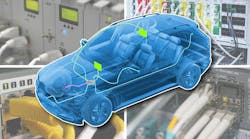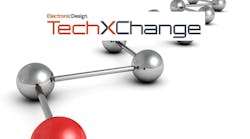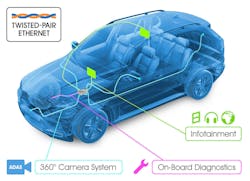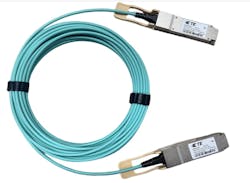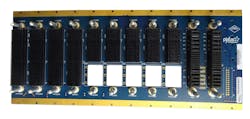Ubiquitous Ethernet and Its Many Protocols
Members can download this article in PDF format.
What you’ll learn:
- Why is Ethernet ubiquitous?
- What are all of the incarnations of Ethernet?
- What does Ethernet look like in different markets?
IEEE 802.3 has been around for 50+ years. These days, Ethernet can be found everywhere, from cars to drones to cloud servers (Fig. 1). It now operates at from 10 Mb/s to 800 Gb/s and supports connectivity regardless of the speeds involved through the help of Ethernet switches.
The technology started with 10-Mb/s coax cabling (10BASE5). Twisted-pair and RJ45 connectors quickly replaced that, while fiber optics was implemented for high-speed, long-distance communication. Currently, Transmission Control Protocol/Internet Protocol (TCP/IP) makes up most Ethernet traffic. These common protocols enable a 10-Mb/s device to communicate transparently with cloud servers running at 800 Gb/s with Ethernet adapters.
Ethernet now covers dozens of IEEE 802.3 standards. They address everything from speeds and connections to routing and security. Though Ethernet usage spans across many areas, its various incarnations are tailored to one or more application areas, including consumer/commercial, automotive, industrial, and enterprise/cloud.
Covering all of the Ethernet standards and options takes books to cover in detail. So, instead, we’ll look at some of the different aspects of Ethernet that developers and designers should be aware of, to perhaps take advantage of particular Ethernet implementations.
Single-Pair Ethernet is More than Reducing Wire Count
One example of a relatively new Ethernet standard is single-pair Ethernet (SPE). The RJ45 jack mentioned earlier uses four wire pairs. Lower-speed connections can get by with two pairs, while higher-speed implementations require all four pairs. Cabling quality and shielded versus unshielded cables resulted in designations from CAT1 through CAT8, with variants like CAT5e and CAT6a. CAT6 is shielded and will handle 10-Gb/s Ethernet.
The copper wire cable limit is 100 m. This is normally associated with the 10BASE-T, 100BASE-T, and 1000BASE-T standards for 10 Mb/s, 100 Mb/s, and 1 Gb/s respectively. The 10BASE-T1, 100BASE-T1, and 1000BASE-T1 SPE standards have the same throughput, but employ a pair of wires no longer than 15 m. It’s more than sufficient for many applications such as cars and industrial equipment.
Others in the mix are 10BASE-T1L that supports a 1-km distance and 10BASE-T1S, also known as 802.3cf 10-Mb/s single-pair Ethernet (10SPE). It pays to go back to the IEEE standards when in doubt.
Just to add to the confusion, there are various Power-over-Ethernet (PoE) standards. Suffice it to say that PoE options are available for the SPE solutions in addition to the conventional copper Ethernet solutions.
Delivering Power-over-Ethernet
Power-over-Ethernet (PoE) is a way to provide power and communication signals on the same set of wires. This works because data is transmitted at a higher frequency than power. There are different PoE standards and some use different wires for power and data. The latest 90-W PoE brings more power to devices. The original IEEE 802.3af-2003 provided 15.4 W per port.
The reason for PoE is to reduce the number of wires and power supplies involved as well as simplify the devices. Voice-over-IP (VoIP) telephones were some of the original targets for PoE (Fig. 2). The technology works equally well for remote sensors, cameras, and controls like those spread through an automobile or an industrial system.
An individual PoE power supply can be paired with a single cable connection, but power is typically provided using a PoE-capable Ethernet switch. It can often be configured in terms of PoE support and power capability per port.
Timing on Ethernet
The IEEE 1588 Precision Clock Synchronization protocol works with any packet-based system like Ethernet but doesn’t turn conventional Ethernet into a deterministic system. Originally, Ethernet used a collision-based detection system, with its multidrop cabling making determinism very difficult. The move to a point-to-point, switch-based, full-duplex system helped, yet the approach still lacked suitable determinism.
Industrial Ethernet implementations like EtherCAT and EtherNet/IP addressed that issue. Lately, though, time-sensitive networking (TSN) has come into play, providing open, industry-wide support for deterministic Ethernet.
As it turns out, TSN is great for Ethernet, but it’s not restricted to a wired connection. Wireless TSN (WTSN) is also possible using ecosystems like Wi-Fi.
CC-Link IE is an Ethernet-based system supported by the CC-Link Partner Association (CLPA). The CPLA standard combines Ethernet with TSN. TSN under IEEE consists of a set of standards for different aspects or purposes. For example, IEEE Std 802.1Q-2022 for bridges and bridged networks is one of the base standards for TSN. And there are profiles like IEEE Std 802.1BA-2021 for Audio Video Bridging (AVB) Systems. Having TSN span both wired and wireless networks is important for the same reason that other protocols like TCP/IP can span the network.
Implementing TSN on Ethernet or Wi-Fi requires additional hardware, although it’s possible to implement the protocol using some real-time processors or FPGAs. In all cases, bandwidth can be allocated to deliver reliable, deterministic communication.
Securing the Ethernet
Ethernet communication is able to operate without encryption or authentication. Protocols and communication built on Ethernet can employ these tools to provide secure and authenticated communication, but it’s also possible to employ this at the network level.
IEEE 802.1AE MACsec security and IPSec provide complementary security support that works with Ethernet. IPSec operates at OSI Layer 3 using end-to-end tunnels to provide security. MACsec is a Layer 2 protocol that works with IEEE 802.1x KeySec. This allows it to secure traffic like ARP and DHCP packets.
Automotive and Industrial Ethernet
Standards like 100BASE-T1S are often referred to as automotive or industrial Ethernet. However, they don’t have to be used exclusively for those tasks nor do designers need to limit themselves to those systems unless they meet their needs. This will be true for software-defined vehicles (SDVs) and self-driving cars that must move massive amounts of data, potentially requiring fiber-optic connections rather than copper.
Another consideration when designing networks for these applications is alternative networks such as CAN. CAN is a simple and well-supported protocol on most microcontroller families, but Ethernet has the edge when it comes to speed and functionality.
FlexCAN or CAN with a flexible data rate (CAN-FD) provide more throughput; still, they can’t match Ethernet. Their main claim to fame is deterministic communication that’s provided by TSN, hence the migration to TSN-based Ethernet. Ethernet with TSN support is more complicated to implement than CAN or CAN-FD, but the simplification on the software side makes it more desirable.
Tanks, Clouds, and Very Fast Ethernet
Many automotive and industrial applications are faring well with Gigabit Ethernet or even pushing 10G Ethernet. However, certain applications require even higher speeds, such as hyperscalers and cloud servers, where interfaces of 100G Ethernet are common. These may push the limits to 400G or even 800G. Copper still works for very short runs, but fiber is required for any distance, even just moving outside the box.
Racks of servers and switches may be built with different Ethernet connections depending on network needs. Low-speed connections are often used for out-of-band (OOB) system management, while very high-speed connections provide backbone links to multiple racks.
Optical cabling is often used in noisy environments or where longer distances are required. Optical Ethernet cables can be active or passive. The former includes transceivers in the connections (Fig. 3); passive cables plug directly into adapters or switches.
Military and avionic system designers have been turning to open standards like OpenVPX that utilize Ethernet for backplane support for control and data-plane connections. VITA creates the standards for these systems, including backplane and mezzanine card standards (Fig. 4).
The Sensor Open Systems Architecture (SOSA) is built on existing standards like VITA’s OpenVPX. SOSA is being used extensively to deliver compatibility and high-performance-computing (HPC) support in new military and avionic applications.
Protocols Over Ethernet
TCP/IP tends to be as ubiquitous as Ethernet, although it spans all sorts of network hardware including wireless connectivity. However, it’s not alone in what type of traffic can be handled by Ethernet. Covering all of the protocols that work with Ethernet is likely to take another book.
A number of protocols can be used over Ethernet connections, such as RDMA over Converged Ethernet (RoCE) and NVMe over Fabric (NVMe-oF), just to mention a few. How this affects timing, switches, and security, as well as coexistence with other protocols, will be protocol- and system-specific.
History of Ethernet
Robert Metcalfe’s name is synonymous with Ethernet. He was one of the founders of 3Com, a major player in the emerging Ethernet space. In 1976, he published a paper with David Boggs entitled “Ethernet: Distributed Packet-Switching for Local Computer Networks.”
The creation and evolution of Ethernet was actually a collaborative effort that involved many engineers and companies. The Voices of Ethernet video series highlights some of those involved with the development and creation of standards for Ethernet.
Those who remember the early days of Ethernet may recall multidrop 10BASE2, which employed RG-58 coaxial cable. It used a collision-based mode of operation. Versions of SPE support multidrop, but most Ethernet systems leverage full-duplex, point-to-point connections via an Ethernet hub or switch.
Read more articles in the TechXchanges: Single-Pair Ethernet and Time for Time-Sensitive Networking (TSN).
